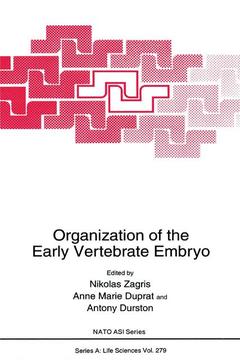Description
Organization of the Early Vertebrate Embryo, 1995
NATO Science Series A: Series, Vol. 279
Coordinators: Zagris Nikolas, Duprat Anne Marie, Durston Antony
Language: English
Subjects for Organization of the Early Vertebrate Embryo:
Publication date: 07-2013
336 p. · 15.5x23.5 cm · Paperback
336 p. · 15.5x23.5 cm · Paperback
Description
/li>Contents
/li>
This book is the product of a NATO Advanced Study Institute of the same name, held at the Anargyrios and Korgialenios School on the island of Spetsai, Greece, in September 1994. The institute considered the molecular mechanisms which generate the body plan during vertebrate embryogenesis. The main topics discussed included: commitment and imprinting during germ cell differentiation; hierarchies of inductive cell interactions; the molecular functioning of Spemann's organizer and formation of embryonic axes; the extracellular matrix and the cytoskeleton in relation to morphogenesis and cell migration; neurogenesis and patterning of the neuraxis; the regulation of pattern formation by Hox genes and other transcription factors. This ASI was marked by a number of special features. An important one was that it brought together three different generations of embryologists: pioneers in classical embryology; scientists who are now leading the present molecular elucidation of vertebrate embryogenesis; and the promising younger ASI participants, some of whom are already making important contributions to this field. This aspect was very important in determining the character of the meeting. It exposed ambiguities in the classical embryological dogma and thus facilitated a subtle application of the recent molecular findings to classical problems. The second shining feature of this ASI was its evolutionary emphasis. The findings presented were obtained in four different vertebrate systems: mammals (the mouse), avians (the chicken), amphibians (Xenopus) and the teleost fishes (zebrafish).
Primordial Germ Cells in Mammals.- Epigenetic Programming of Gene Expression and Imprinting in Mouse and Human Embryonic Development.- Comparison of Poly(A)-degrading Activity in the Avian and Mammalian Oocytes.- Microtubule Pattern During Cytoplasmic Reorganization of the Fertilized Xenopus Egg: Effect of UV Irradiation.- The Formation of Mesoderm and Muscle in Xenopus.- Regulation of Cell Fate by Processed Vg1 Protein.- Target Site Determination for Xenopus laevis Fork Head related Transcription Factors.- eFGF Regulation of Mesoderm Formation and Patterning during Gastrula Stages.- The Role of Insulin-like Growth Factor II in the Growth and Development of the Mammalian Embryo.- Early Avian Morphogenesis Leading to Gastrulation in the wider context of Vertebrate Embryogenesis.- Mapping of Gastrulation Movements in Birds.- Morphogenetic Movements in the Avian Blastoderm: Mechanism and Dynamics.- Hensen’s Node: The Amniote Equivalent of Spemann’s Organizer.- The Extracellular Matrix in Development.- The Expression of the Genes for Laminin in the Early Embryo.- Structure and Function of Cadherins.- An Elevation of Internal Calcium Occurring via L-type Channels Mediates Neural Induction in the Amphibian Embryo.- Determination of Glial Lineages during Early Central Nervous System Development.- In Vivo and in Vitro Studies on the Differentiation of the Neural Crest in the Avian Model.- Retinoids and Axial Patterning in the Early Vertebrate Embryo.- The Pax Family of Transcription Factors in Embryonic Development.- Homeobox Genes in the Developing Head of Vertebrates.- Neuronal Organization of the Embryonic Fore- and Midbrain in Wild Type and Mutant Mice.- Early Events in Establishment of the Vertebrate Heart.- Ectopic Expression of Wnt-1 Induces Abnormalities in Growthand Skeletal Patterning of the Limbs.- Differentiation of the Splanchnopleure in the Genital Area: Morphological and Experimental Investigations on Avian Embryos.- Participants.
© 2024 LAVOISIER S.A.S.




